The Bagpipe Society
Grace Notes
Welcome to The History Special! This is an edition I’ve wanted to do since taking over as editor 6 years ago but as history is a field so close to my heart, I always thought it a tad self-indulgent to produce it. However, following the AGM at the Blowout in 2019 several people came up to me and suggested that the history of bagpipes and bagpiping would be a good theme for a special edition. So here it is! It’s taken well over a year to put together and I would like to thank all the contributors who have responded so positively and enthusiastically to my requests for an article. They have all come up trumps!
I have long been an admirer of the group Piffaro and they have been an inspiration for my own group, PIVA. Listening to their recordings it is clear that they have a love of bagpipes. Co-founder and director of Piffaro, Joan Kimball, gives a fascinating insight into how the group has incorporated bagpipes into their music and their arrangements. I’m very grateful, as I’m sure you will all be too, for Joan’s generosity in making some of their recordings and arrangements available to members (see the link by her article). Another musician I greatly admire is Bill Lyons. He is a moving force in Early Music and is director of The City Musick and The Dufay Collective as well as fulfilling an academic role as a professor at the Royal College of Music. His study into the role of the bagpiper from the 12th to 17th centuries sheds a light on how the fortunes of the instrument and player changed during this period.
No-one can fail to be amazed at the research and the craftsmanship that has produced the reproduction of Settala’s Sourdeline. I hope that you have all, like me, seen the videos of Marco Tomassi’s playing, either on YouTube or Facebook, and then been staggered by the sheer beauty of the sound as well as the spectacle of his achievement. I am honoured that Eric Montbel and Marco Tomassi agreed that Chanter should be the publication in which they share their story of this instrument and their journey to reproduce it. The article highlights that the sourdeline was the precursor of the more familiar musette and one of the masters of this instrument today is, without doubt, François Lazarevitch. He has, with his group, Les Musiciens de Saint-Julien, brought a fresh and innovative approach to baroque and traditional music in both recordings and live performance. The interview with him by Andrea Kirkby gives us a fascinating insight into his techniques and approaches to musical interpretation.
As there is a dearth of surviving bagpipes from before the 18th century research into the early development of the instrument is reliant on organographical resources. Danilo Turchetti started a Facebook group a few years ago with the aim of capturing early representations of bagpipes in Italy. The variety and scope of images he and his team have collected are a source of both delight and great interest as I come across them in my Facebook feed and I hope his article will bring the site he manages more admirers for the valuable work he is carrying out. Moving forward to the 16th century, considered by some to be the heyday of the instrument, there can be few people who are unfamiliar with the woodcut illustrations by Michael Praetorius of bagpipes and other instruments of the period. And because they are so familiar there is a danger that we do not really look and think about them. Eric Moulder, a long admirer of Praetorius, (a chronicler, musician, composer and organ builder) sheds an interesting light on these depictions and makes us realise how little we really do know about the bagpipes in Syntagma Musicum.
When I first relayed the discovery of the long-lost portrait of Hale the Piper in Chanter in 2013, I suggested that my research into Hale and the picture was going to continue. I am pleased to be able to share my findings with you and to bring you up to date. I also give details of another exciting discovery I made along the way.
Finally, to the subject of In the Bag. Sadly, there’s no time machine available to go back and interview a piper from the past about their musical influences. So, Andy Letcher needed to think a little bit outside the box – I hope you all enjoy reading about one of today’s iconic performers on bagpipes!
I hope you all enjoy reading the History Special!
Help required from the Bagpipe Hive Mind!
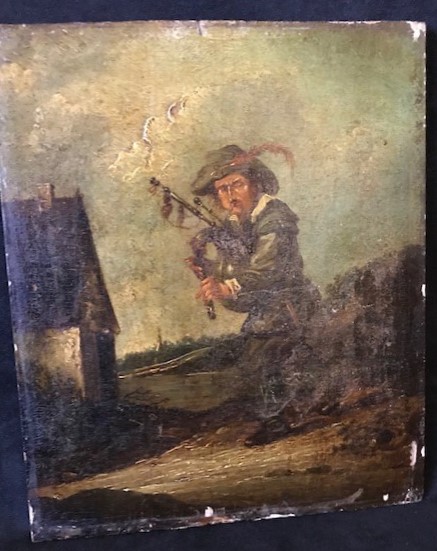
The Bagpipe Society recently received an enquiry from a non-member asking if anyone could shed any light on a recent auction purchase. Roger Miller is a keen amateur collector of antiques and has a liking for paintings. He explained that he is drawn to things that he can hold so he can imagine the life they have had and this gives him a springboard to research and gain as much knowledge about the object and its times. The painting he bought is of a piper and it was described by the auction house as ‘19thC Dutch or Flemish School, a man playing bagpipes’. He believes the painting to be older than this, possibly late 17th/early 18th century and thinks the European attribution is correct. The painting is on a wood panel and clearly needs restoring.
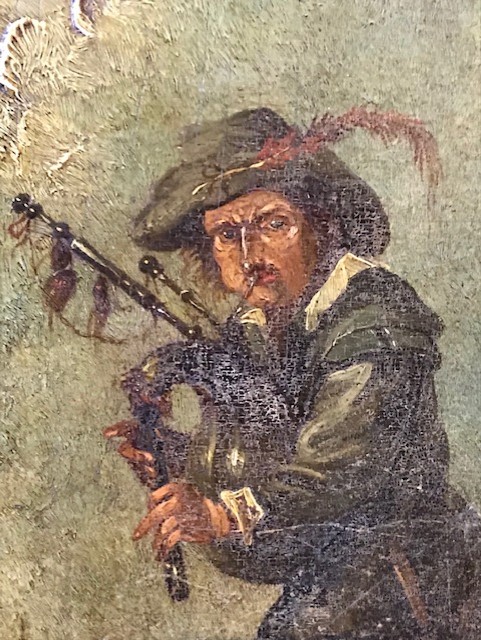
He is under no illusions and doesn’t expect to discover he has an unknown grand master but considers that it could have some historical interest. In doing some research, he came across The Bagpipe Society. He is now appealing to the collective knowledge of its members! If you have any information or suggestions that could help Roger discover more about his new acquisition, then please contact me (email on rear cover) and I will forward it to him.
Online Teaching from Remi Decker!
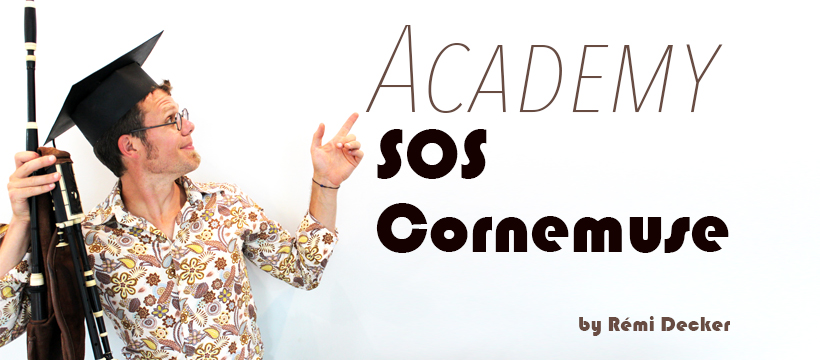
In September 2020, SOS Cornemuse entered a new dimension with “real” online bagpipe courses. It’s with great pleasure that I offer you my 20-year teaching experience, with the promise to pay attention to your remarks, your requests and your challenges. The whole wrapped up in seriousness and humour.
It works a bit like a subscription service with different options available and it’s 100% Corona proof ;-). Every month you get a recorded lesson and according to the option you have chosen, you can get some feedback from me, or a video meeting. Besides that, I propose a starter kit for total beginners: 10 mini lessons to get started with pipes. This starter kit lasts until you can play one tune. During this period, you can send me some videos of how you are doing and I’ll try to keep you on the right track. I have at the moment around 15 “followers” and could go to 20 - max 25.
All lessons are in French spoken, English (and Dutch) subtitled. Communication in any of the 3 languages. Payment by bank transfer or Paypal.
Remi Decker
Beautiful Leather Bagpipe Bags made to order
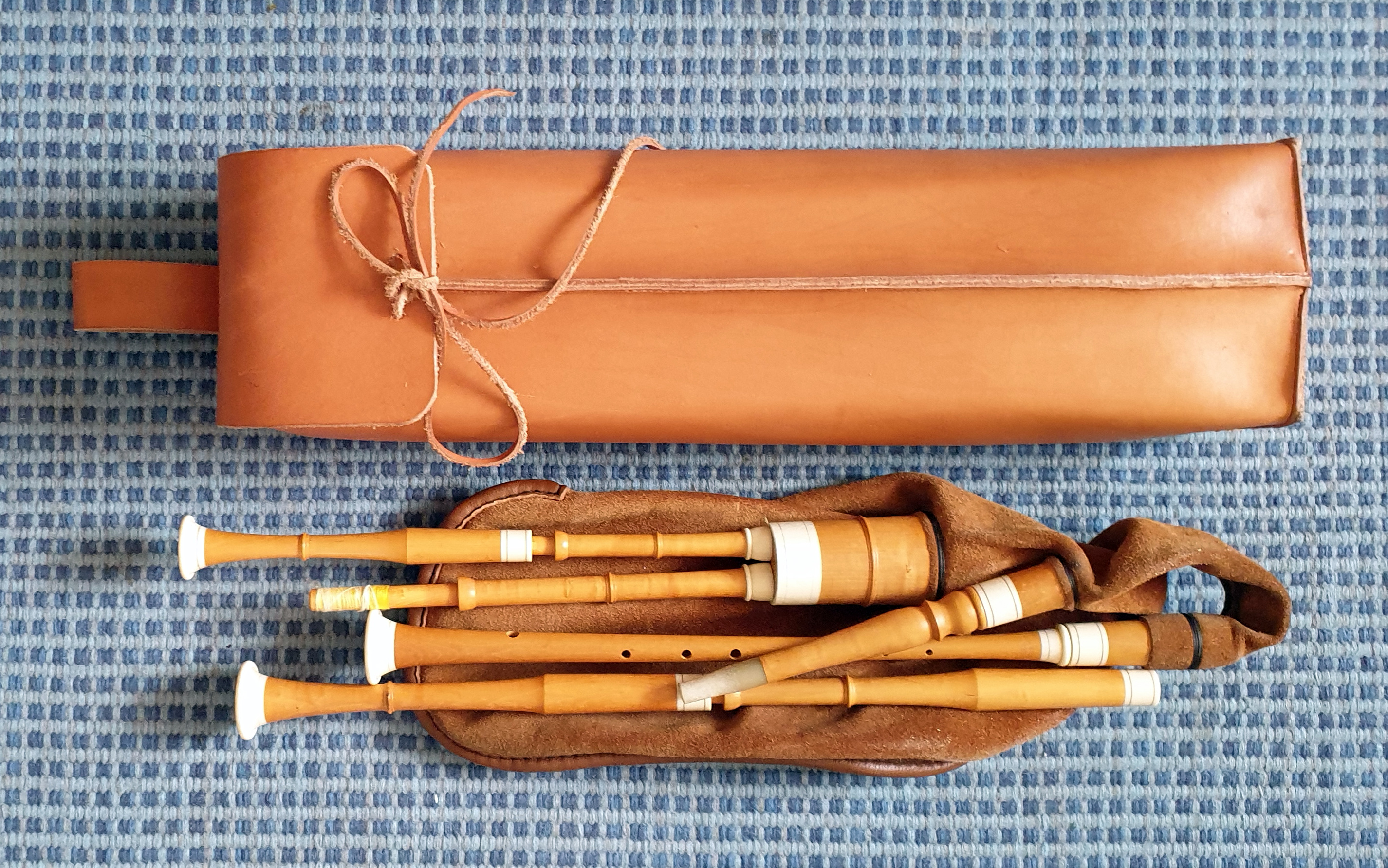
Rosalie Bosteels is a Flemish artist, film maker and craftsman who makes leather bags for bagpipes and other folk and historical woodwind instruments. She also plays bagpipes. The most popular bag she makes is for one set of bagpipes in ‘G’ and she adapts the design/sizing for pipes in any key – mouth blown or with bellows - and for two or more sets of pipes, or for any combination of pipes and other woodwind instruments. The sizing is generous enough to accommodate spare reeds, sheet music and the usual bits and pieces pipers carry around (you can squeeze in a bottle of Flemish beer).
All the bags are made from high quality cow hides from a local tannery and are cut and stitched by hand. No machine stitching, metal or plastic. They have a shoulder strap and are finished with five coats of saddle oil. The bags are sturdy (the bag for a single bagpipe in ‘G’ weighs just over a kilo), weather proof and offer a lot of protection while being breathable. Prices start at £180 for a bag for a single mouth blown bagpipe in ‘A’, ‘B flat, ‘G’ or ‘F’.
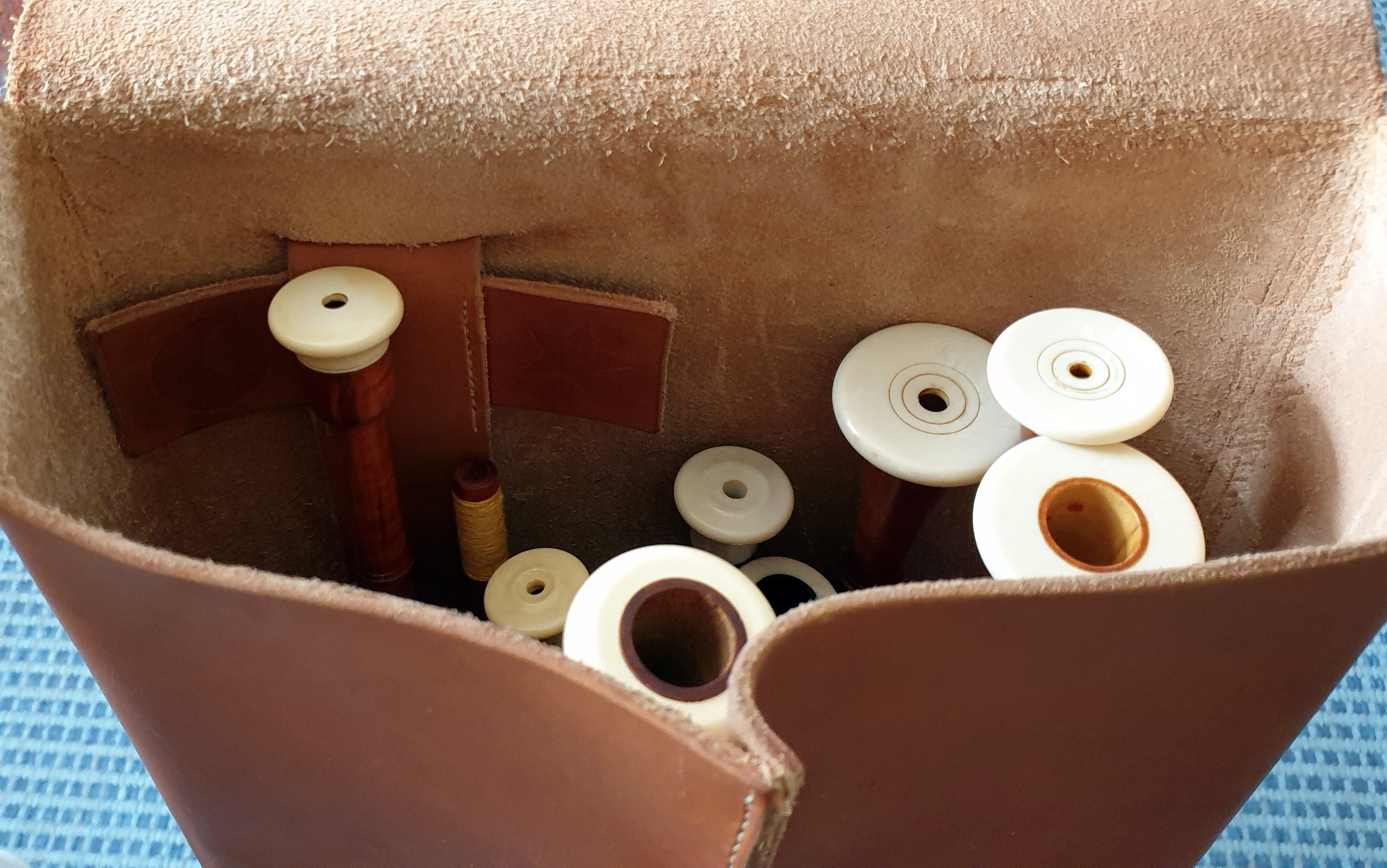
Rosalie.bosteels@gmail.com or search Rosalie Bosteels on YouTube. The bagpipes in the photos are in ‘G’, ‘F’ and ‘D’ by Jon Swayne.
Here is a link to a delightful video showcasing the bag with some nice bagpipe accompaniment by the one and only Paul James! http://bit.ly/Chanter105
- Data Processing Notice (GDPR)
@BagpipeSociety on X (formally known as Twitter)
TheBagpipeSociety on Instagram
 BagpipeSociety on Facebook
BagpipeSociety on Facebook
Something wrong or missing from this page? Let us know!
